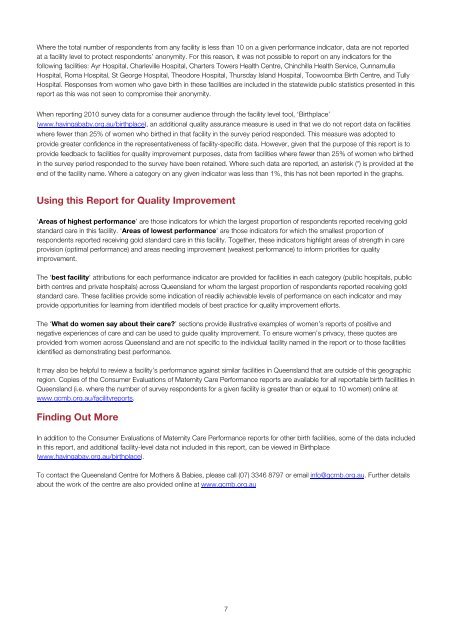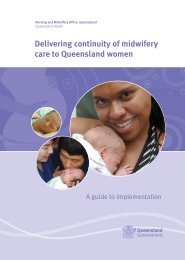Gold Coast Birth Centre - Queensland Centre for Mothers & Babies
Gold Coast Birth Centre - Queensland Centre for Mothers & Babies
Gold Coast Birth Centre - Queensland Centre for Mothers & Babies
Create successful ePaper yourself
Turn your PDF publications into a flip-book with our unique Google optimized e-Paper software.
Where the total number of respondents from any facility is less than 10 on a given per<strong>for</strong>mance indicator, data are not reported<br />
at a facility level to protect respondents’ anonymity. For this reason, it was not possible to report on any indicators <strong>for</strong> the<br />
following facilities: Ayr Hospital, Charleville Hospital, Charters Towers Health <strong>Centre</strong>, Chinchilla Health Service, Cunnamulla<br />
Hospital, Roma Hospital, St George Hospital, Theodore Hospital, Thursday Island Hospital, Toowoomba <strong>Birth</strong> <strong>Centre</strong>, and Tully<br />
Hospital. Responses from women who gave birth in these facilities are included in the statewide public statistics presented in this<br />
report as this was not seen to compromise their anonymity.<br />
When reporting 2010 survey data <strong>for</strong> a consumer audience through the facility level tool, ‘<strong>Birth</strong>place’<br />
(www.havingababy.org.au/birthplace), an additional quality assurance measure is used in that we do not report data on facilities<br />
where fewer than 25% of women who birthed in that facility in the survey period responded. This measure was adopted to<br />
provide greater confidence in the representativeness of facility-specific data. However, given that the purpose of this report is to<br />
provide feedback to facilities <strong>for</strong> quality improvement purposes, data from facilities where fewer than 25% of women who birthed<br />
in the survey period responded to the survey have been retained. Where such data are reported, an asterisk (*) is provided at the<br />
end of the facility name. Where a category on any given indicator was less than 1%, this has not been reported in the graphs.<br />
Using this Report <strong>for</strong> Quality Improvement<br />
‘Areas of highest per<strong>for</strong>mance’ are those indicators <strong>for</strong> which the largest proportion of respondents reported receiving gold<br />
standard care in this facility. ‘Areas of lowest per<strong>for</strong>mance’ are those indicators <strong>for</strong> which the smallest proportion of<br />
respondents reported receiving gold standard care in this facility. Together, these indicators highlight areas of strength in care<br />
provision (optimal per<strong>for</strong>mance) and areas needing improvement (weakest per<strong>for</strong>mance) to in<strong>for</strong>m priorities <strong>for</strong> quality<br />
improvement.<br />
The ‘best facility’ attributions <strong>for</strong> each per<strong>for</strong>mance indicator are provided <strong>for</strong> facilities in each category (public hospitals, public<br />
birth centres and private hospitals) across <strong>Queensland</strong> <strong>for</strong> whom the largest proportion of respondents reported receiving gold<br />
standard care. These facilities provide some indication of readily achievable levels of per<strong>for</strong>mance on each indicator and may<br />
provide opportunities <strong>for</strong> learning from identified models of best practice <strong>for</strong> quality improvement ef<strong>for</strong>ts.<br />
The ‘What do women say about their care’ sections provide illustrative examples of women’s reports of positive and<br />
negative experiences of care and can be used to guide quality improvement. To ensure women’s privacy, these quotes are<br />
provided from women across <strong>Queensland</strong> and are not specific to the individual facility named in the report or to those facilities<br />
identified as demonstrating best per<strong>for</strong>mance.<br />
It may also be helpful to review a facility’s per<strong>for</strong>mance against similar facilities in <strong>Queensland</strong> that are outside of this geographic<br />
region. Copies of the Consumer Evaluations of Maternity Care Per<strong>for</strong>mance reports are available <strong>for</strong> all reportable birth facilities in<br />
<strong>Queensland</strong> (i.e. where the number of survey respondents <strong>for</strong> a given facility is greater than or equal to 10 women) online at<br />
www.qcmb.org.au/facilityreports.<br />
Finding Out More<br />
In addition to the Consumer Evaluations of Maternity Care Per<strong>for</strong>mance reports <strong>for</strong> other birth facilities, some of the data included<br />
in this report, and additional facility-level data not included in this report, can be viewed in <strong>Birth</strong>place<br />
(www.havingabay.org.au/birthplace).<br />
To contact the <strong>Queensland</strong> <strong>Centre</strong> <strong>for</strong> <strong>Mothers</strong> & <strong>Babies</strong>, please call (07) 3346 8797 or email info@qcmb.org.au. Further details<br />
about the work of the centre are also provided online at www.qcmb.org.au<br />
7
















